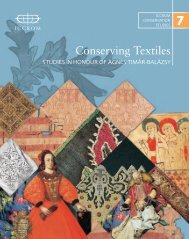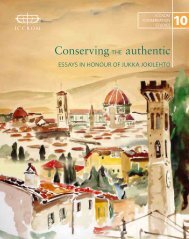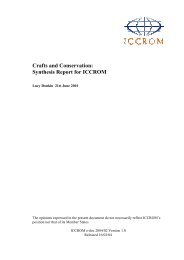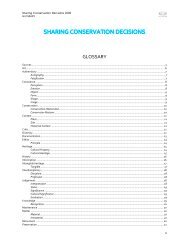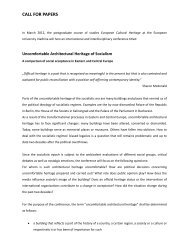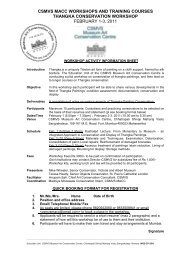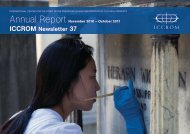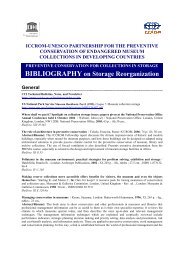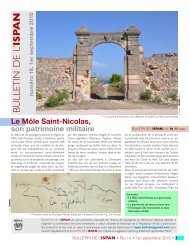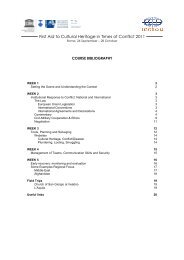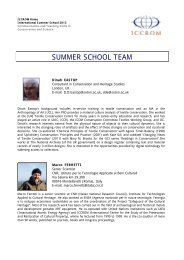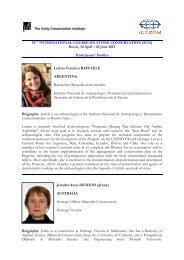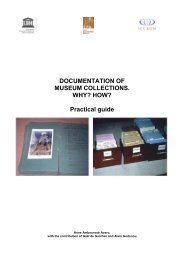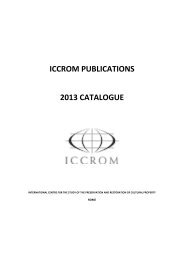part 1 - Iccrom
part 1 - Iccrom
part 1 - Iccrom
Create successful ePaper yourself
Turn your PDF publications into a flip-book with our unique Google optimized e-Paper software.
MEASURING HERITAGE CONSERVATION PERFORMANCE<br />
6th International Seminar on Urban Conservation<br />
gathered from interviews with people who have<br />
been linked to the Saint Peter of the Clerics Courtyard<br />
for many years; people who have lived,<br />
worked or frequented the place and noted how it<br />
has changed over time. More than just the length of<br />
time spent in the courtyard, there is the feeling of<br />
belonging to the place that has, in fact, turned them<br />
into ‘mistresses of the house’, or the ‘hosts of the<br />
courtyard’. The record of active effects has led to an<br />
oral memory database having been compiled for the<br />
site, something that will be of extreme importance<br />
for future research on the courtyard.<br />
1.10. The community’s <strong>part</strong>icipation<br />
In parallel with the morphological and historical<br />
research, three educational and decision-making<br />
workshops were held in which the community and<br />
government authorities took <strong>part</strong>. It could be seen,<br />
based on the contact with the owners and tenants<br />
of Saint Peter of the Clerics Courtyard properties,<br />
that the best remembered aspect of its history for<br />
them was that of its bohemian years, which began<br />
in the 1960s. Themes that sprang out from the<br />
research undertaken included religious occasions,<br />
the black presence, vestiges of Dutch urbanism, the<br />
Portuguese occupation and the artistic wealth of the<br />
Baroque, which were not sufficiently known by the<br />
community, who were surprised by the relevance of<br />
the values found in the place where they live.<br />
1.11. The towns of Água Branca, Delmiro<br />
Gouveia and Olho d’Água do Casado - Alagoas<br />
The third experience we have had and the one<br />
which guided the construction of the methodology<br />
presented here was based on the project ‘Identifying<br />
the Cultural Assets in the Towns of Água<br />
Branca, Delmiro Gouveia and Olho d’Água do<br />
Casado – Alagoas’. 10 The aim of this investigation<br />
was to record the cultural assets to which tools for<br />
their protection could be applied. We identified a set<br />
of 29 assets that were fit for protection, and these<br />
included isolated buildings, urban groupings and<br />
cultural landscapes. Some of the assets identified<br />
as having cultural value came to be institutionally<br />
recognized as being <strong>part</strong> of cultural heritage of Alagoas,<br />
such as the buildings with the internal and<br />
external registry and the whole area of the complex<br />
of the former hydroelectric plant of Angiquinho in<br />
the municipality of Delmiro Gouveia. 11<br />
Research in the towns of Água Branca, Delmiro<br />
Gouveia and Olho d’Água do Casado was motivated<br />
by the absence of studies on identifying cultural<br />
assets in which there is interest in preservation<br />
as well as by the lack of recommended safeguards<br />
for the elements listed, given the prospect of change<br />
in the economic and physical-territorial structures<br />
of the region of the Lower São Francisco, which<br />
would, undoubtedly, affect the existing heritage<br />
assets.<br />
Thus, a methodology was used that interrelated<br />
historical and documentary research, identification<br />
of assets and the reading of the urban morphology.<br />
The historical method was indispensable<br />
for identifying and preserving the memory of the<br />
cultural asset, in that being able to identify it was<br />
made possible based on recognizing the dimensions<br />
that defined and characterized it in times past and<br />
present.<br />
1.12. Historical and documentary research<br />
Thus, the manuscript, bibliographic and iconographic<br />
documentation, alongside the oral sources,<br />
constituted the material that was fundamental to<br />
recomposing the identity, memory and physical<br />
transformation suffered by the place in its historical,<br />
morphological and aesthetic dimensions. Using<br />
these sources, the themes that supported the interpretation<br />
and construction of the historical narrative<br />
were defined.<br />
Within the procedures necessary for interpretation,<br />
the following steps were performed: preliminary<br />
knowledge of the towns by means of the reading of<br />
secondary sources; construction of indices; and visits<br />
to the registries and archives, including virtual<br />
ones, after having consulted and recorded bibliographic<br />
and iconographic sources. The first sources<br />
were recorded on 29 reading cards, including rare<br />
works, and the second sources consisted of maps,<br />
plans and about 1,406 photographs. After listing the<br />
sources, we proceeded to organize the documents,<br />
checking for consistency, identifying key themes<br />
and the direction that interpretation was taking.<br />
After concluding the historical research, we moved<br />
on to surveying the information in situ.<br />
1.13. Identifying the assets and<br />
reading the urban layout<br />
The identification of in situ assets consisted of:<br />
exploratory, systematic and confirmatory surveys,<br />
and also of compiling supplementary material.<br />
Each stage of the survey had different and complementary<br />
objectives, namely:<br />
Exploratory survey: This was guided by suggestions<br />
from experts with knowledge and experience<br />
of the region and its history, and direct observation<br />
Ribeiro, C.; Lira, F.; Piccolo, R. & V. Pontual. 2012. Conserving and identifying heritage: A methodological contribution. In Zancheti,<br />
S. M. & K. Similä, eds. Measuring heritage conservation performance, pp. 15-25. Rome, ICCROM.<br />
19



